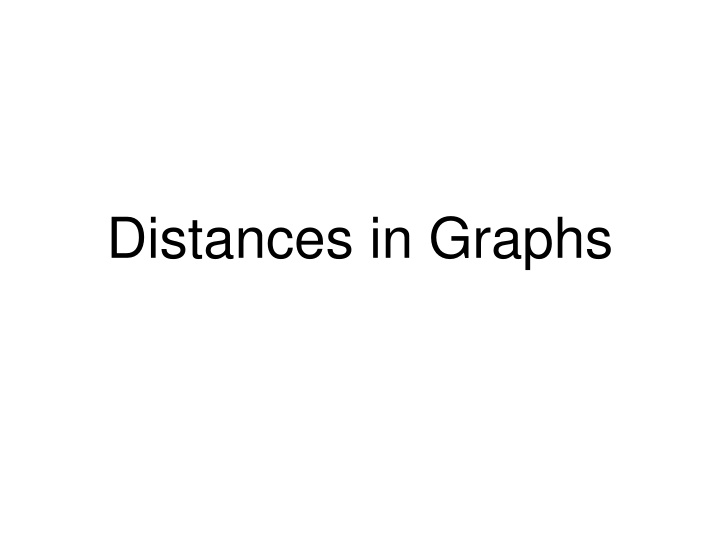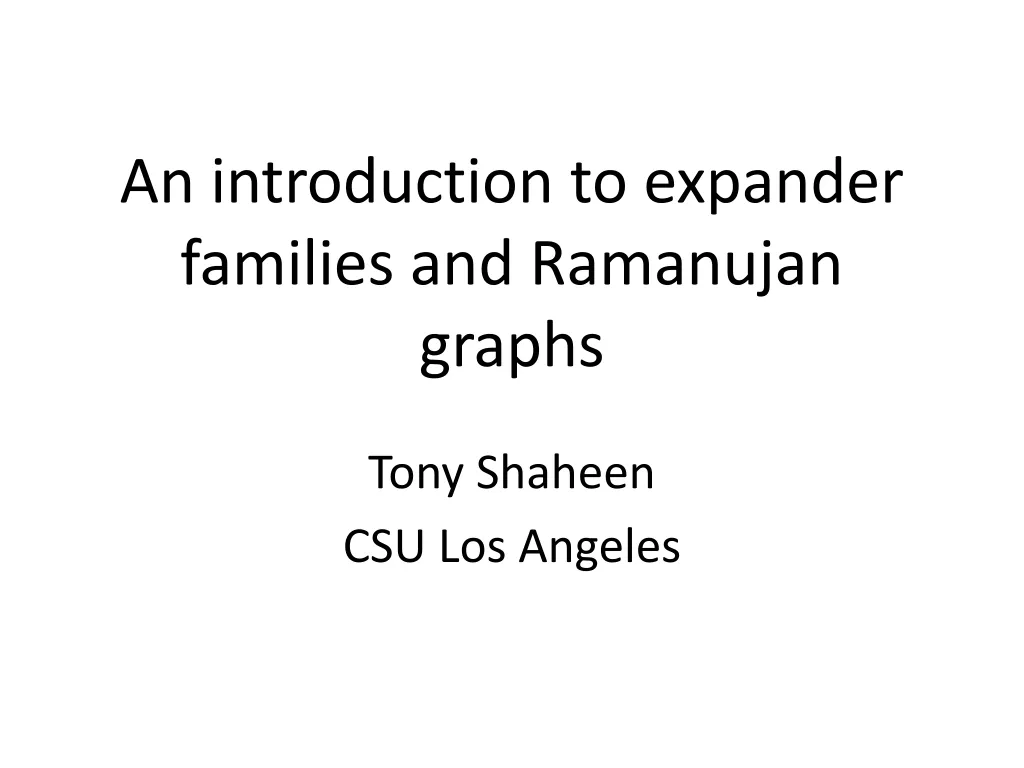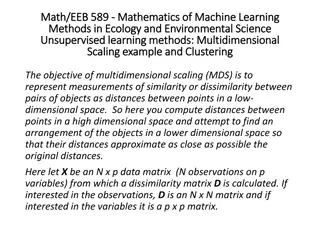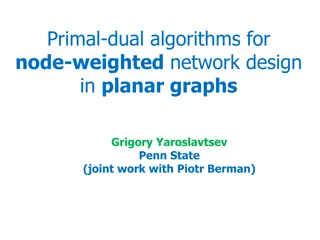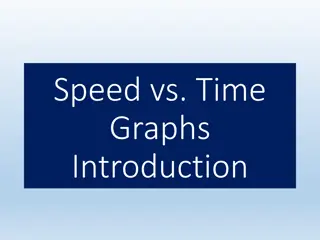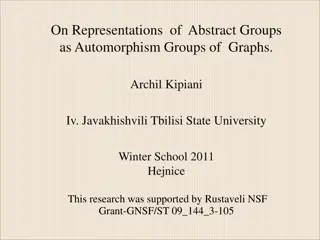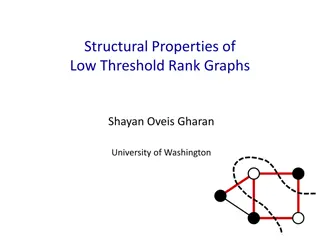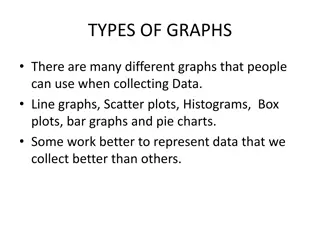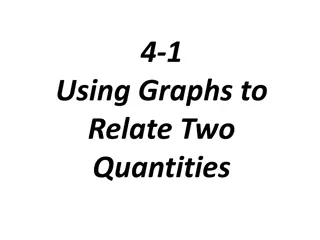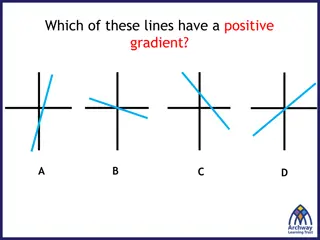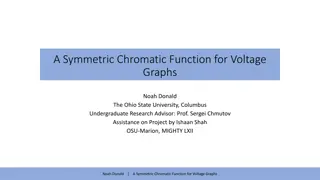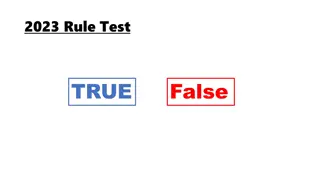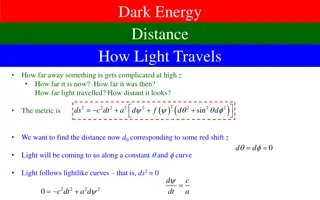Distances in Graphs
In this visual guide, explore various distance algorithms for calculating distances in graphs, including single source to single destination, single source to all destinations, and all sources to all destinations. Learn about directed and undirected graphs, positive and negative weights, relaxation techniques, and the Bellman-Ford single source distance algorithm. Dive into examples and understand how distances are calculated and optimized.
Download Presentation

Please find below an Image/Link to download the presentation.
The content on the website is provided AS IS for your information and personal use only. It may not be sold, licensed, or shared on other websites without obtaining consent from the author.If you encounter any issues during the download, it is possible that the publisher has removed the file from their server.
You are allowed to download the files provided on this website for personal or commercial use, subject to the condition that they are used lawfully. All files are the property of their respective owners.
The content on the website is provided AS IS for your information and personal use only. It may not be sold, licensed, or shared on other websites without obtaining consent from the author.
E N D
Presentation Transcript
Distance Algorithms Calculating distances in graphs Single source - single destination Single source - all destinations All sources - all destinations Directed Graphs Undirected Graphs
Distance Algorithms Graph has only positive weights Graph can have negative weights but not a negative cycle
Distance Algorithms Negative cycle example: What is the distance from a to f
Distance Algorithms a-b-d-f costs 3 a-b-c-d-f costs 0 a-b-c-d-e-d-e-b-d-f costs -2 and a few more times around the cycle costs even less
Distance Algorithms Single Source Algorithms: Relaxation Fundamental approach to maintain estimates for distances Assume for each vertex, we have an upper bound for the distance from the source Relaxation then improves the distance bound towards the true value
Distance Algorithms Example
Distance Algorithms Relaxation: ?.? distance bound for distance between ? and ? Let (?,?) ?. We relax along (?,?) by setting ?.? ??? ?.?,?.? + ?(?,?)
Distance Algorithms Relaxation: In addition, we can maintain a predecessor field at all nodes Because we do not only want the distance, but also how we got there When we relax, we set the predecessor field in ? to ? if we replace ?.? with ?.? + ?(?,?) because the latter is smaller
Bellman-Ford Bellman-Ford Single Source Distance Algorithm We initialize by: Source ? gets distance 0 and itself as predecessor Every node ? adjacent to ? gets distance ?(?,?) and predecessor
Bellman-Ford Best path from source ? to node ? cannot have more than |?| 1 edges in it So, we relax with every edge a total of |?| 1 times If we can relax afterwards, something is fishy: We have found evidence for a negative cycle
Bellman-Ford def Bellman_Ford(s, V, E): initialize(s,V,E) for i in range(len(V)-1): for (u,v) in E: relax(u,v) for (u,v) in E: if relax(u,v) changes the distance in v: return 'negative weight cycle detected' return 'done'
Bellman-Ford Example: After initialization
Bellman-Ford Relax here
Bellman-Ford Relax here
Bellman-Ford Relax here
Bellman-Ford Relax here
Bellman-Ford Relax here
Bellman-Ford Relax here
Bellman-Ford Relax here
Bellman-Ford Relax here
Bellman-Ford Relax here
Bellman-Ford Relax here
Bellman-Ford Relax Here
Bellman-Ford Relax Here
Bellman-Ford Now, we can start again
Bellman-Ford The second round, nothing changed This was an easy example, after all We can therefore shortcut the rest, decide that there are no cycles, and finish
Bellman-Ford Now, let's create a negative weight cycle b-d-e-f-b
Bellman-Ford The first time around, we would get something like this Your mileage will vary because of choices in the ordering of edges
Bellman-Ford If we relax along d-e, we get
Bellman-Ford Then we can relax along e-f
Bellman-Ford Then along f-b
Bellman-Ford After we relax with (b,d), we see that the predecessor graph no longer reaches s. We also can see that every time we relax with the edges in the graph, we lower distances,
DAG's If we have a directed acyclic graph: We can use topological sort of vertices: ? = [?1,?2,?3, ,??] We then execute for u in U: for v in u.adjacency: relax with (u,v) This is a very fast algorithm for DAG's only
Dijkstra's Algorithm Single source all destinations algorithms that only assumes that weights are all positive Also uses a Greedy strategy Builds a subset S of nodes for which the exact distance is known
Dijkstra's Algorithm Example: Dijkstra starts with just the source in ? We initialize all nodes (but do not write infinities here)
